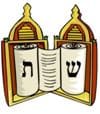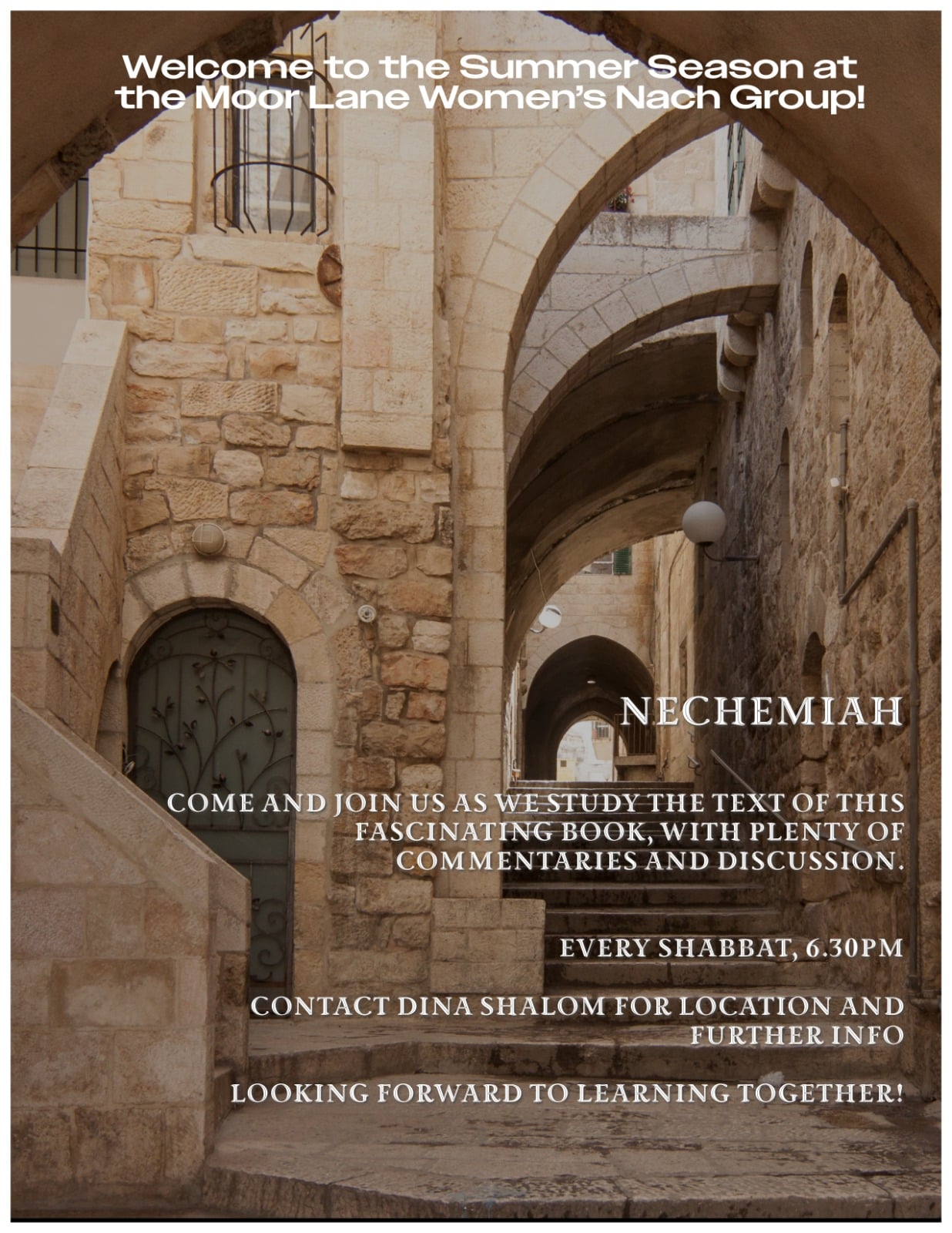
ק׳ ק׳ שׁערי תפילה

*****
🕯️🕯️
This Shabbat is
1) Parashat Matot – Mase
&
2) Shabbat Rosh Chodesh
📖 📖
2 Sefarim will be taken out
1) Matot – Mase
2) Rosh Chodesh (from וביום השבת)
📜
The Haftara will be
1) Haftara of Mase (שִׁמְע֥וּ דְבַר)
followed by the
2) 1st & last Passuk of the haftara of Rosh Chodesh
****

*****

לוח זמני תפלה לקיץ תשפ״ה
Summer Timetable 5785 – 2025
מוצאי שבת | ערבית )מוצ”ש( | שקיעה | סוף זמן קראת שמע | זמן שבת | פלג מנחה (תה״ד) | פלג מנחה (לבוש) | מנחה וקבלת שבת | תאריך | שבת פרשת |
Shabbat Ends | Arbit | Sunset | Shema to be read before | Candles to be |
| Earliest Candle lighting | Minha & Kabbalat Shabbat* | Date | Parasha |
PM | PM | PM | AM | PM | PM | PM | PM |
|
|
10:20 | 10:16 | 9:13 | 9:15 | 9:01 | 8:15 | 7:37 | 7:20 | 25/26 July | מטות־מסעי) ר”ח( |
🕯️SUMMER TIMES FOR SHABBAT 🕯️
שבת
קרבנות
9:00 am
הודו
9:15 am

מנחה
6:30 pm
****

****
Matot
Moshe teaches the rules and restrictions governing oaths and vows, especially the role of a husband or father in either upholding or annulling a vow. The Bnei Yisrael wage war against Midian. They kill the five Midianite kings, all the males and Bilaam. Moshe is upset that women were taken captive. They were catalysts for the immoral behavior of the Jewish People. He rebukes the officers. The spoils of war are counted and apportioned. The commanding officers report to Moshe that there was not even one casualty among the Bnei Yisrael. They bring an offering that is taken by Moshe and Elazar and placed in the Ohel Mo'ed (Tent of Meeting). The Tribes of Gad and Reuven, who own large quantities of livestock, petition Moshe to allow them to remain on the eastern side of the Jordan River and not enter the western Land of Israel. They explain that the land east of the Jordan is quite suitable grazing land for their livestock. Moshe's initial response is that this request will discourage the rest of the Bnei Yisrael, and that it is akin to the sin of the spies. They assure Moshe that they will first help conquer the Land of Israel, and only then will they go back to their homes on the eastern side of the Jordan River. Moshe grants their request on condition that they uphold their part of the deal.
Masei
The Torah names all 42 encampments of the Bnei Yisrael on their 40-year journey from the Exodus to the crossing of the Jordan River into Eretz Yisrael. Hashem commands the Bnei Yisrael to drive out the Canaanites from the Land of Israel and to demolish every vestige of their idolatry. The Bnei Yisrael are warned that if they fail to completely rid the Land of the Canaanites, those who remain will be “pins in their eyes and thorns in their sides.” The boundaries of the Land of Israel are defined, and the tribes are commanded to set aside 48 cities for the Levites, who do not receive a regular portion in the division of the Land. Cities of refuge are to be established so that someone who unintentionally kills another person may flee there. The daughters of Tzlofchad marry members of their own tribe so that their inheritance will stay in their own tribe. Thus ends the Book of Bamidbar/Numbers, the fourth of the Books of the Torah.
Ohr Somayach Institutions www.ohr.edu

קטב מרירי – בריכה בין המצרים
במדרש שוחר טוב על ספר תהלים אמרו על הפסוק “מדבר באופל יהלוך”, רבנן אמרי (חכמים פירשו), שד הוא (שד, כלומר מין מזיק שנברא בערב שבת בזמן בריאת העולם, והוא דמות שאינה רוחנית כמו המלאכים, אבל גם אינו גשמי ממש כמו בני האדם), רבי הונא בשם רבי יוסי אמר, קטב מרירי עשוי כמין קליפין קליפין, שערות שערות, עינים עינים, ובעין אחת הוא רואה, ועינו לתוך לבו, ואינו שולט לא בצל ולא בחמה, אלא בין חמה לצל, ומתגלגל ככדור, ושולט מארבע שעות ועד תשע, “ושולט משבעה עשר בתמוז עד תשעה באב”, וכל מי שרואה אותו נופל על פניו ומת. ובמדרש רבה מובא, “כל רודפיה השיגוה בין המצרים”, בימים אלו, משבעה עשר בתמוז עד תשעה באב, שבהם קטב מרירי מצוי. ומבואר אם כן בדברי רבותינו אשר כל רז לא נעלם מהם, כי בימים אלו של בין המצרים, מצוי מזיק, ושמו קטב מרירי, ויש לכך השפעה על האופן שבו עלינו להתנהג בימים אלו.
יש להזהר שלא ללכת לבד בימים אלו מתחילת שעה רביעית של היום עד סוף שעה תשיעית, שבסך הכל הם שש שעות. (ושיעור שעות אלו, היינו שמונים שלוש שעות מעלות השחר, ומאז יש להזהר בכל זה במשך שש שעות. ושעות אלו הן שעות זמניות, דהיינו בימים אלו בארץ ישראל, כל שעה זמנית היא שעה ושליש השעה. ובסך הכל שמונה שעות רגילות, בערך מהשעה שמונה ורבע בבוקר ועד השעה שתיים בצהריים).
ומבואר בדברי הערוך השלחן, שאין איסור בזה אלא בדרך שאין שם בני אדם כלל, כגון מי שהוא מטייל ביערות וכיוצא בזה, אבל בתוך העיר במקום שבני אדם מצויים שם, מותר ללכת יחידי. (ויש המחמירים אף בתוך העיר, אך לא נהגו כן).
כמו כן יש להזהר מאד בימים אלו בשעות שאמרו שקטב מרירי מצוי בהן, שלא לעשות שום דבר שיש בו סכנה. ויש אריכות בענינים אלו במדרשים ובדברי הפוסקים.
ולכן, רבים השואלים, האם מותר ללכת לבריכה בימי בין המצרים? התשובה היא, שמותר, אבל אלו ימי סכנה, ולכן יש להזהר במשנה זהירות, הן בנסיעות, והן ברחיצה, ובפרט להשגיח היטב היטב על הילדים לבל יסתכנו, וכן הזהירו הפוסקים בזמנם, שהיו מכים את הילדים לצורך חינוכם, שבימים הללו היו נמנעים מזה, שמא יגרמו חס ושלום לפציעה ונזק, ומן הדברים נלמד כמה הזהירות חשובה בזמנים הללו, וה' יבשרנו בשורות טובות וישמור את עמו ישראל מכל רע.
“Ketev Meriri”- Swimming During the “Three Weeks”
The Midrash Shocher Tov on Tehillim states regarding the verse (Tehillim 91) “From the pestilence that walks in darkness”: “The Sages explain that this refers to a demon (a harmful being created on Erev Shabbat at the time the world was created and is neither fully spiritual like angels nor fully physical like human beings). Rav Huna said in the name of Rabbi Yose that the ‘Ketev Meriri’ demon is made of many peels, many hairs, and many eyes. It sees with one eye and this eye is within its heart. It has no power either in the sun or in the shade; rather, its power is between the sun and the shade. It rolls around like a ball and has power from the fourth hour of the day until the ninth. It has power from the Seventeenth of Tammuz until the Ninth of Av. Whoever sees it falls over and dies.” Similarly, the Midrash Rabba on the verse “All of her enemies overtook her between the straits” explains that this refers to the three weeks between the Seventeenth of Tammuz and the Ninth of Av when “Ketev Meriri” is present. This means that our Sages, who were fluent in all of the secrets of the world, tell us that there is a harmful demon called “Ketev Meriri” present during this period of the “Three Weeks” and we must therefore conform our behavior and be aware of this fact during this period of time.
One must take care not to walk around alone during these three weeks beginning from the fourth hour of the day until the end of the ninth hour, which is a total of six hours. (The way to calculate these hours is from dawn, meaning that one must begin being careful from after three hours after dawn have passed for a duration of six hours. These hours are seasonal halachic hours, i.e., in Israel each halachic hour during this time of year is approximately and hour and a third. Thus, six halachic hours amount to approximately eight regular hours from approximately 8:00 am until 2:00 pm.)
The Aruch Ha’Shulchan points out that this prohibition only applies in a place where there are no people around at all, for instance, if one is walking through a forest and the like; however, within the city where people are present, it is permissible to walk around alone. (There are those who rule stringently even within the city, but the custom is not so.)
Similarly, one must take care not to perform any dangerous activities during the time “Ketev Meriri” is present. The Midrash and Poskim speak lengthily about this issue.
Thus, when many people ask whether or not swimming is permissible during the Three Weeks, the answer is that it is (for Sephardic Jews, even during the week during which Tisha Be’av falls out, as long as the pool is not heated). However, one should be aware that these are dangerous days, and one should take care while driving, traveling, swimming, and any other activity to do so as safely as possible. One should be especially careful to supervise children well during this period. Indeed, the Poskim write that even in earlier generations when it was commonplace to strike children in order to educate them, this should not be done during the Three Weeks so that the child is not injured unintentionally. We can infer how important safety during this period is.
May Hashem share good tidings with us and protect the Jewish nation from all evil, Amen.